| Our
Story Steve & Barb Shortreed |
||
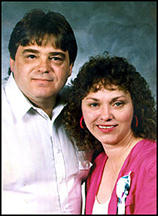
Factory work was boring and I hated the shift work. I would amuse myself by creating cartoons of my co-workers and supervisors on paper towels. Everyone enjoyed the cartoons so much they would volunteer to watch my machine, to give me more time to draw. I dreamed of a business of my own, where I would be master of my destiny. The Turning Point
Mohawk College in Brantford, Ontario offered an evening course in sign writing. Mom and the new hubby signed up to take it together. At the last moment, she remembered my interest in painting and called to see if I would like to take the course with them, kind of a family get-together. The school was 50 miles away, but I signed up and began to attend three nights a week. The instructor gave us all a #10 red sable that first night
and had us practice strokes on banner paper. I was fascinated with how clean the
Mom's new hubby pulled me to the side and in a muffled, excited voice shared with me how another student had told him of some friend-of-a-friend who had made $30,000 painting signs part-time his first year. This was a pile of bread back in the early 70's, over twice what I was making at my factory job. It also turned out to be modern-day folklore. Remember the kid in England that was dying of cancer and wanted cards from around the world? That one still surfaces from time to time. Or my all-time favorite: the Corvette you can buy for $500, only catch is a guy died in it and was not found for several weeks. I first heard the Corvette story as a kid, and my 17- year-old, Adam, recently rushed home to tell me he also had heard about it. Likewise, it took another 10 years before I even got close to that $30,000 painting signs. Out On My Own
A trip to the city resulted in a treasure of old Letraset catalogs and a chance to sneak a look at other sign painters' work. Sometimes I would drive by their shops and try to catch a glimpse inside, or trace old signs to see how they were laid out and painted. Meeting The Competition
One day I got up enough nerve to phone a sign joint and ask if I could visit their shop, and perhaps even ask some questions about the sign business. The owner actually laughed at me, told me I was wasting my time and screwing up things for the pros. He had secrets that had taken a lifetime to master, he explained, and he was not about to share them with anyone. I hung up feeling angry and rejected. Instead of giving up, I vowed to do whatever it took to learn this business. Another turning point!
At this point I still had my factory job, but I dreamed of someday making signs full time. Unfortunately, getting the One-Shot out of our bedroom worked too well! Another daughter, Amanda, arrived in December that year, followed by Adam the following December. The steady paycheck and benefits from the day job were just too good to leave behind. Enter The Letterheads
Over the next few years I watched the Letterhead movement
grow as members relocated around the country and shared the idea with other sign artists.
I just knew I needed to be with them if I wanted to get anywhere. These guys became my
heroes (still are today), along with many others I have met along the way. Although I
couldn't afford to meet them in person, I still felt a kinship with these craftsmen as I
followed their exploits and successes. We did everything they suggested without
By 1982, I was able to give up the factory job and build
signs full time. Noel Weber hosted the "Boise Bar-B-Q" at his new home in Boise,
Idaho. He invited additional craftsmen from around the country, and things really began to
grow. Mike Jackson hosted the "Oklahoma Bash"
in Moore, Oklahoma that October and 135 sign artists showed up. At this point in my
career, I still had never seen an Sometime in the spring of 1983, we read of a meet in Kansas City. Without even thinking, I placed a call to Ron Overby at Magik Signs and announced we were coming. We put together a quick portfolio of our work and in August, armed with our newly acquired credit card, we boarded a plane for Kansas City and our first Letterhead Meet. First Meet I'll never forget entering that shop for the first time. We went a day early to try and get oriented, and it seemed everyone had the same idea. To say I was star-struck is an understatement! My heroes were everywhere: Noel Weber, Mark Oatis and Kent Smith were working on restoring an old gold sign. I ran from one person to the next, shaking their arms off and generally making a fool of myself. Mike Jackson was doing a workshop on sandblasted signs and I wrote furiously in my notebook, trying to copy down every word he said while Barb snapped pictures.
At every Letterhead meet, it is a custom to reserve a special table where everyone is urged to display their work. It's called the Portfolio Table, and I tossed mine in the pile and began to leaf through everyone else's work. An Identity Crisis
That night we were invited to have dinner with Mark and
Jeannie Klein, a couple from Miami whose work I had always admired. Later, back at the
hotel I confessed how I had hidden my portfolio. The two of them made me run up to our
room Jeannie passed away a few years later from a brain tumor, but I still think of them often and take every opportunity I have to thank them for stretching the truth a bit about my work. They could have destroyed any self-confidence I still had at that point, but instead they chose to build me up. Mark and Jeannie are probably responsible for me still being in the business today. Thanks For The Memories Most Letterheads will tell you the meet they recall best is
their first. I agree completely! I can still see Ken Millar standing on a makeshift stage,
conducting a workshop on layout. Some guy with big ears had on display the finest
showcards I had ever seen. He introduced himself as Mike Stevens. Little did we dream of
the books and videos, not to mention the influence and inspiration, that M I met a sign painter from Chicago called Bob Behounek, and watched with envy as he lettered his wonderful scripts. Keith Kneith, another of my heroes from the Toledo area, teamed up with Steven Parrish, an old-time gold leaf master, and these two kept me in stitches with their stories and tall tales. Impromptu seminars and workshops were breaking out everywhere I turned. Noel Weber, Bob Bond and Kent Smith taught me how to lay gold leaf, and Mike Jackson sat outside and talked sandblasted signs with me for over an hour. The show went on into the wee hours of the morning, and I made sure I was the last out the door each night. We flew home loaded with new knowledge and inspiration, not to mention a whole bunch of new friends. We were on fire! Letterhead fanatics! The Movement Grows
The basic rule of thumb has been, "If you want to have a Letterheads meeting-have one." That person or group decides the format, location, fees charged if any, and all other details. All you really need to do to hold your own meeting is put on some coffee, break out the BBQ, and invite some other shops. Ask them to bring a portfolio and their sign kits. The rest will come naturally. The only thing to remember is that what you give, you will get back in spades. Taking Turns
Many shop owners were skeptical of our motives. Some expressed fears their employees would be lured away by other shops, while others decided we were out to sell them something. When the big night arrived, about 40 people showed up. Ken Millar treated everyone to his Chicagoland sign slide show, while others began painting and demonstrating their "secrets" with their newfound "brothers of the brush." Before long, everyone was sharing tips and tricks and we had a real Letterhead Meet going. I've never seen many of those people since then, but out of that first meeting we found Doug Downey, Peter Payne, Bevin Finlay and so many others that are now part of our Southern Ontario Signcrafters group. This group has hosted large, very successful meetings in Newmarket, Welland and Cornwall over the years, and is pleased to host Discovery '96 in Stratford, Ontario on July 26, 27 & 28. Since Stratford is famous for its Shakespearean Festival, this year's theme was "Signs of Shakespeare", and many of us were done up in Old English garb. A Medieval Feast was held, in addition to the Discovery Workshops and hands-on projects. The Computer Age Our shop, The SignMan continued to grow and expand. We bought a Gerber 4B in 1985, the first in the area. I can still remember writing the check. The 4B was selling for $15,000, and I bought 20 fonts at $500 each. To a guy who had never had a loan for over $2,000, this $25,000 bill was a fortune. We never even realized the 4B was a computer, just considered
it a letter-cutting machine. Despite my reservations, the 4B proved to be a great
production tool and quickly paid for itself. We outgrew the garage and leased a shop on a
well-traveled highway. Our major customer was an awning company and we had all the work we
could handle. We hired a couple employees, bought a 15-hp
Things began to change in 1991. Awning sales began to drop off as money got tighter. The newspapers were filled with stories of recession and even depression. The technology was also quickly changing as PCs became cheaper, and heat transfer replaced spray as a way of decorating awnings. I liked the freedom we enjoyed with spray and resisted the change. At this point we were still using the Gerber 4B, and I just couldn't see changing. Hitting The Wall With all the PC cutting systems hitting the market, sign prices kept tumbling. We were forced to lay off a wonderful and gifted employee who had been with us for three years, due to lack of work. It's not easy to lay off anyone, let alone a friend. To be honest, I must admit I was responsible for many of the
problems. We were very weak on sales, and most of our work was referral. Creative types
are generally afraid of sales and the feeling of rejection that comes with a
"no". I also had too many eggs in one basket: by just concentrating on the
awnings, I had no varied customer base to Cash flow at the shop had really dropped, and I did what men always tend to do when faced with a wall: bang my head against it and hope things would change. Working around the clock, I tried to do the work of three people. At 40 years of age I had put on some weight and smoked, but I reasoned that since I had given up drinking and partying, one bad habit would be offset by a good habit. Anyway, who had time for parties? I would try to work 30-40 hours straight, and then sleep 10 hours. The stress began to pile up almost as fast as the bills. Bad News Begins
Helping my wife, Barb, set out the kids' presents early that Christmas morning in 1993, I found myself growing very angry at myself and my inability to properly provide for my kids. Barb went on to bed, but I sat downstairs, raging at myself. The pain started in my chest, nothing too extreme but enough to be concerned. I began to sweat, and felt all clammy. I tried to convince myself it was just indigestion, or a touch of angina at worst. It's funny what goes through someone's mind at these times. I knew there was a good chance I was having a heart attack, but I still remembered Mom's warnings about always wearing clean underwear. After showering and putting on clean shorts, I finally woke Barb around 3 am and suggested I better go to the emergency room. I tried to appear real cool on the outside, but inside I was terrified. My Uncle Bill had died just 2 months before of a massive coronary, and I wondered if Bill and I might be sharing breakfast together.
I laid in my hospital bed that Christmas morning and it suddenly occurred to me I was worth more dead than alive. I just had to get back to the shop! Despite my doctor's warnings, I was back at the shop within hours of leaving the hospital. Barb was not pleased with me, but I was stubborn: gonna show them all! I sure showed them all right...in early March I found myself back in the emergency room, suffering a second heart attack! This time I knew something had to change. My way was just not working anymore.
We decided Barb would run the business while I designed layouts on the computer at home. This was somewhat successful, but we still had to dip into our savings to cover the bills. Our Letterhead friends were terrific, showing up out of the blue to help out Barb. Pete and Marj Payne in particular always seemed to "just be in our area," even though they live 90 miles away. Thanks to all of you. I became a hermit, hiding from the world in my garage workshop at home. I'm not sure if I was more afraid of dying, or living. That first year I sat in front of the computer all day and night. After I worked my way up to course champion in PGA Golf, I took up flying on Microsoft Flight Simulator. Before long I was ferrying people coast to coast in my cyber 747. Sometimes I wouldn't even stop when Barb called me for supper, fearing my passengers might get killed while I filled my face. It seems funny now, but back then it was no joke. My withdrawal from reality was affecting the family and business. Friends would call and try to get me to go places, but I always refused. I quit going to Letterhead Meets because I no longer felt I was a signpainter, and I didn't want my friends to see how heavy and weak I had become.
Into The Internet When the computer games became boring I learned how to join BBS's, or Bulletin Board Services. These offered loads of free stuff to download and the opportunity to chat live with others on the same service. Our phone bills were getting outrageous, as I would join chatlines all over North America. I'd try to only stay 10 minutes, but most days I was online for hours. My life was out of control.
That first month I was online for almost 350 hours. Sometimes I would sit in front of the screen for 15 hours at a time. The World Wide Web is an exciting place. Clicking on icons and special highlighted words (called hyperlinks) instantly takes you from one site to another. An individual or company's site is called a home page, or website. To me, these home pages were nothing more than electronic storefronts. Since I had spent over 20 years designing signs for storefronts, I became excited at the prospect of earning money by designing these home pages for others. For the first time in two years I felt alive again. I became convinced the Internet was my best chance to once again support my family. Web Basics
Over the next few weeks I learned to scan, edit, and add photos and graphics to my pages. I set up a page with links to all my favorite spots on the web, and then went to work on a page about Fergus and our family. This was really fun, and I was learning at the same time. My time was now divided between surfing the web and talking with friends around the globe on IRC, short for Internet Relay Chat. IRC is the Internet version of CB radio. An unlimited number of people can gather on one channel or room and talk about anything they want. There are literally thousands of channels available with topics to suit any taste. You won't believe it until you see it! What's really neat is you can actually exchange files with others while you are chatting. Photos and graphic files are especially popular. From time to time I would use the Internet search utilities to look for other sign painters. In the summer of 1995, all I could find was about 25 other sign shops. I began to write them e-mail and was overjoyed when they responded. Looking For Letterheads My searches under Letterhead only led me to stationery store sites, and I wondered why nobody had up a Letterhead site. This is when I decided to create a home page for Letterheads myself, and turn it over to someone more worthy down the line. I figured it would be just a hobby. The first Letterhead Web site was pretty plain. I used an old logo well-known to everyone in the movement, and started a list of sign shops on the Internet. A page that informed people of Coming Events was next, closely followed by a page on schools and workshops for the trade. The next project was a page listing all the magazines and resources that serve our industry. The names and e-mail addresses I already had were added to a new Sign Shops Around The World Page, and I began a data file to keep track of everyone. By the end of the summer we had close to 50 shops on board. It was around this time I discovered another sign-related site out of Orlando, Florida. I thought the site was terrific and fired off some e- mail to tell them so. I was shocked the next day to receive a call from Orlando. It was the company president himself! He seemed like a nice guy, and thanked me for my input. When I inquired why there was nothing on Letterheads, he confessed he had never heard of them and asked who they were. I answered all his questions, told him all about our little site, and invited him to visit it. The following day he called back and said that after checking around, he now understood how important the Letterhead Movement was and wondered what I thought he could do to attract more of us to his web site. He went on to say he understood all the work and time it requires to maintain a web site, and offered to take the Letterhead site off my hands. I promised to think about it. An Industry Legacy The only reason I related this story was to show how close I came to giving this site away. I had serious doubts about my ability to do the kind of job a site like this deserves. Keeping the site meant I would have to be willing to invest even more time and money, both of which were in very short supply. Just keeping up with the changing technology would be a job in itself, and then there was the biggest question of all: How were we going to generate operating capital, let alone some kind of an income with the site? I called Kent Smith, Dave Butler, and a few other Letterheads to get their feedback, and everyone seemed to agree it should be kept in Letterhead hands. With their blessings and encouragement, Barb and I made the decision to go forward and develop the Letterhead Website. The first thing we did was to close down our large shop and move the SignMan back home. Although we were forced to sell some of the large equipment, we would save on overhead costs. Barb continued to operate the sign business, leaving me free to develop the website. I found a 16-year-old computer whiz kid from British Columbia named Kris Benson, who was a great help with the more technical aspects of the site. With his help we added Bull Board, a page where people could post their questions to be answered by others, express opinions, relate stories or list buy-and-sell items. This continues to be the heart of The Letterhead Website. Over 1,000 sign makers visit this page on an average day. For the first year, all new shops registering at the website were entered manually to a list of shops. I had no understanding of databases or automated programs that could do this for us. That all changed when I met Piotr Pytlik, a brilliant computer programmer from Kitchener, Ontario. Thanks to Peter, we soon had a wonderful new tool...The Letterhead Website Database. This tool gave us the ability to search and generate lists of Letterheads from every corner of the World. A few months later, he gave us a similar database for our suppliers. One day soon, The Letterhead Website Supplier Database will be the place sign makers search first whenever they need something. Chatting It Up There was still no live chat forum for the sign industry, so I went to work on setting one up. Internet Relay Chat (or IRC) was the best way to go, but the existing networks were clogged by growth and were prone to breakdowns. A new chat network called DALnet was just being developed, and I made a decision to develop Letterhead Chat on their server. In those early days, there was only a handful of signshops able to use IRC. We agreed to meet each night at 10 p.m. EST, and invited everyone to include their spouses and family in the fun. The folks on IRC pick "nicks" to call themselves, much like a CB handle. Barb is "Barb2U" and I am "SignMan". As the chat channel grew, we installed a new IRC ChatPals Page on the web site that contained info on who everyone really was, as well as photos of themselves. Using a utility called DCC, we are able to send sound, graphics, text and photo files to each other. At present we have around 60 sign companies that use Letterhead Chat regularly, some from as far away as Australia and South America. There is no extra cost to your phone bill, and we encourage you all to find a Internet Service Provider and join us. Our dream is that in the near future this forum will be active 24 hours a day. Get involved now! Shop Pages Another attraction on The Letterhead Web site is our Shop Profile Pages. Each month we try to feature a new shop picked at random from our users. A typical profile contains lots of pictures, as well as the owner's story in their own words. We try to make the profiles as personal as possible; people are more important here than the quality of their work. No "sign gods" on The Letterhead Web site. Everyone is treated as equals here. All types of sign-related people are invited to take part, and we have a number of airbrushers, pinstripers, vinylheads, carvers, calligraphers, graphic artists and sculptors. Our latest project is trying to get sign schools from around the world involved. Students are invited to "ask the pros" and even take on a page of their own here. All our users that own their own shops are offered a free link from The Letterhead Web site to their page or site. We really feel this site is theirs. E-mail addresses are included in the hope that shops will use them like Yellow Pages to contact each other. We continue to search for a few good suppliers to join us as advertisers. I continue to use every search utility available to find and contact new shops just connecting to the Internet. In the past few weeks we have used our IRC chat channel to connect with live Letterhead meets in Seattle, Pacifica and Arkansas. As of October, 1998, The Letterhead Web site has grown to almost 4,000 shops and continues to grow by an average of 150 new shops each month. The Present, The Future That brings us up to the present. It's amazing how events can lead you to places you never imagined. I'm feeling much better about myself and the future. My health is improving and I'm even starting to lose some weight! Finances continue to be tight, but I no longer worry about it like I used to. After two heart attacks, getting rich just doesn't seem as important. Life is too precious and short to not stop and smell the flowers along the way. You'll never hear an old person say "I wish I had worked harder." They always talk about time wasted that could have been spent with family and friends. Despite the setbacks, Barb and I consider ourselves very blessed. We have four healthy, almost-grown children, close friends all over the world, and our time with each other. The Letterhead Web site gives me the opportunity to learn, as well as teach others, about our wacky business. It's nice to think this website may in some way influence a trade that has given so much to me. My heroes are still sign painters, and we hope to meet every one of you in the coming years. To visit The Letterhead Web site you need an Internet hookup and a web browser such as Netscape or Microsoft Internet Explorer. Our address, or URL, is http://www.letterville.com. If you wish to contact us by e-mail, our address is steve@letterville.com . If all else fails, pick up the phone and call 519-787-2673 or 519-843-5191.
Home | Join Us! | Bulletin Board | Letterhead Shops | More Shop Profiles | Supplies
Copyright The Letterhead Website 1995-2004 |
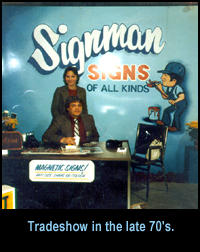 In
high school, I decided a career in auto mechanics was just the thing for me,
until I banged my knuckles a few
times and had various fluids drip into my eyes. Drafting
was kind of like drawing, so I switched courses and majored in machine shop
and drafting. After graduation, I was hired as a chemist by General
Electric, with a promise to move me into the drafting department when
something became available. It was a great job; shirt and tie, my own
secretary, lots of free time, and company benefits. The truth was I found it
very boring, and I quit after 6 months to take a job in a wire and cable
factory.
In
high school, I decided a career in auto mechanics was just the thing for me,
until I banged my knuckles a few
times and had various fluids drip into my eyes. Drafting
was kind of like drawing, so I switched courses and majored in machine shop
and drafting. After graduation, I was hired as a chemist by General
Electric, with a promise to move me into the drafting department when
something became available. It was a great job; shirt and tie, my own
secretary, lots of free time, and company benefits. The truth was I found it
very boring, and I quit after 6 months to take a job in a wire and cable
factory. The years passed. I met and married my
wife, Barb, and we had our first child, Angela. Out of the blue one day, I received a
phone call from my mother that would change my life forever. She had remarried and her new
husband ran a refrigeration business in New Brunswick, Canada. It seems he had hired some
crusty old signpainter down East to letter his station wagon, and he was awestruck at the
outrageous price he paid for the job. It was $75 for both sides! He never forgot that, and
after returning to Ontario he decided the sign business was just made for him. He was
going to clean up. What could be so hard about painting ABCs?
The years passed. I met and married my
wife, Barb, and we had our first child, Angela. Out of the blue one day, I received a
phone call from my mother that would change my life forever. She had remarried and her new
husband ran a refrigeration business in New Brunswick, Canada. It seems he had hired some
crusty old signpainter down East to letter his station wagon, and he was awestruck at the
outrageous price he paid for the job. It was $75 for both sides! He never forgot that, and
after returning to Ontario he decided the sign business was just made for him. He was
going to clean up. What could be so hard about painting ABCs?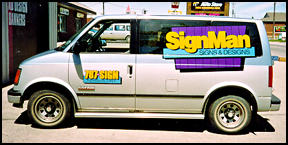 strokes looked, but making them end properly was very difficult. An
"O" would take a lifetime to master!
strokes looked, but making them end properly was very difficult. An
"O" would take a lifetime to master!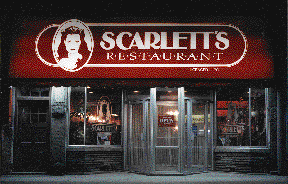 After a month of school, I figured I pretty well had the trade
mastered and opened up a part-time sign business out of the bedroom in our rented
apartment. Mom and the new hubby lasted only two weeks before deciding lettering was not
for them. For some reason, the quill felt natural to me right from the start. A buddy
helped me build a bench, and I would spend hours practicing. Instead of cartoons, I began
drawing letters and then words. I would hit the restroom each day before my shift started
and confiscate a new pack of paper towels to draw on. The Speedball Alphabet book was my
constant companion, and I learned all the typestyle names, as well as how to draw them.
After a month of school, I figured I pretty well had the trade
mastered and opened up a part-time sign business out of the bedroom in our rented
apartment. Mom and the new hubby lasted only two weeks before deciding lettering was not
for them. For some reason, the quill felt natural to me right from the start. A buddy
helped me build a bench, and I would spend hours practicing. Instead of cartoons, I began
drawing letters and then words. I would hit the restroom each day before my shift started
and confiscate a new pack of paper towels to draw on. The Speedball Alphabet book was my
constant companion, and I learned all the typestyle names, as well as how to draw them. That first year was a real adventure. A guy I met at the local Legion
Hall asked me to letter his pickup. I can still feel the paint rolling down my arm as I
tried to paint a vertical door. Somehow, after three days I managed to finish it and the
customer actually seemed pleased. Gave me $40, if I remember right.
That first year was a real adventure. A guy I met at the local Legion
Hall asked me to letter his pickup. I can still feel the paint rolling down my arm as I
tried to paint a vertical door. Somehow, after three days I managed to finish it and the
customer actually seemed pleased. Gave me $40, if I remember right. 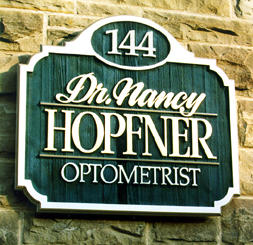 Nineteen seventy-five was a memorable
year. We registered our new business as The SignMan, a name that was my CB handle at the
time. Remember the CB craze? Running a sign shop from our bedroom was beginning to have a
negative effect on our love life, at least as far as Barb was concerned. We somehow
managed to buy a big, old house that had a double garage. I borrowed another $2,000 from
the credit union, and we converted the garage into a real sign shop.
Nineteen seventy-five was a memorable
year. We registered our new business as The SignMan, a name that was my CB handle at the
time. Remember the CB craze? Running a sign shop from our bedroom was beginning to have a
negative effect on our love life, at least as far as Barb was concerned. We somehow
managed to buy a big, old house that had a double garage. I borrowed another $2,000 from
the credit union, and we converted the garage into a real sign shop. 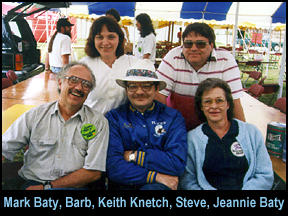 It was
around this time I started reading about a group called the Letterheads. In the early
70's, seven sign artists from the Denver area began getting together to share ideas and
their passion for old signwork and books. Earl Vehill and Mark Oatis were the first
Letterheads, both apprentice sign painters at the time. Also in the union class was Mike
Rielley and Bob Mitchell, who both shared a love of fine art as well as signage. Now there
were four. Rick Flores was the next member to be discovered, closely followed by Noel
Weber, a signpainter from the Chicago area, and John Frazier. As their talents and
craftsmanship sharpened, they began entering the Signs of the Times annual design
competition and generally swept every category. At the bottom of every entry, they wrote
"member Letterheads".
It was
around this time I started reading about a group called the Letterheads. In the early
70's, seven sign artists from the Denver area began getting together to share ideas and
their passion for old signwork and books. Earl Vehill and Mark Oatis were the first
Letterheads, both apprentice sign painters at the time. Also in the union class was Mike
Rielley and Bob Mitchell, who both shared a love of fine art as well as signage. Now there
were four. Rick Flores was the next member to be discovered, closely followed by Noel
Weber, a signpainter from the Chicago area, and John Frazier. As their talents and
craftsmanship sharpened, they began entering the Signs of the Times annual design
competition and generally swept every category. At the bottom of every entry, they wrote
"member Letterheads".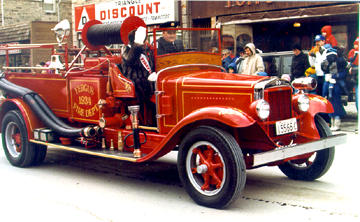 question. At night I would
blow up and trace pictures of their work, trying to understand the thought that went into
these designs.
question. At night I would
blow up and trace pictures of their work, trying to understand the thought that went into
these designs.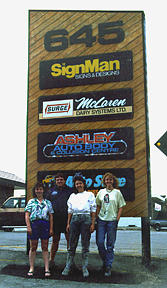 other
sign painter at work.
other
sign painter at work.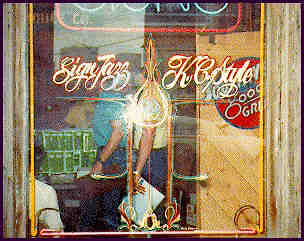 Ellis
Dourghty attracted a large crowd outside as he laid out the shop window and proceeded to
whip off the most beautiful script I had ever seen. Then he got out a funny, long-haired
brush I later learned was a sword stripper, and started to pinstripe a design around the
lettering without even using a guideline. I elbowed my way to the front and stood there
with my lower jaw dragging on the hot sidewalk as he worked. Ellis was the first
signpainter I ever saw. What an act to try to follow!
Ellis
Dourghty attracted a large crowd outside as he laid out the shop window and proceeded to
whip off the most beautiful script I had ever seen. Then he got out a funny, long-haired
brush I later learned was a sword stripper, and started to pinstripe a design around the
lettering without even using a guideline. I elbowed my way to the front and stood there
with my lower jaw dragging on the hot sidewalk as he worked. Ellis was the first
signpainter I ever saw. What an act to try to follow! Now, you have to
remember I was the only sign painter in a small town of 6,000 people, and I was under the
impression that I was just a tad short of excellent. Compared to the signs I had seen in
my little world, I really was! Looking through a few of the portfolios on display, I
quickly came to the conclusion that my efforts were, at best, just above graffiti. I
quickly snapped up my portfolio and headed for the hotel room to bury it. For the first
time it really hit home how much more I needed to learn, and I wondered if I was in the
wrong trade.
Now, you have to
remember I was the only sign painter in a small town of 6,000 people, and I was under the
impression that I was just a tad short of excellent. Compared to the signs I had seen in
my little world, I really was! Looking through a few of the portfolios on display, I
quickly came to the conclusion that my efforts were, at best, just above graffiti. I
quickly snapped up my portfolio and headed for the hotel room to bury it. For the first
time it really hit home how much more I needed to learn, and I wondered if I was in the
wrong trade.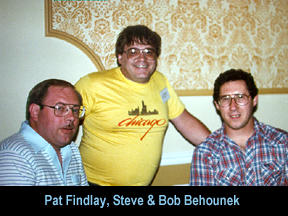 and dig it
up so they could have a look. They promised to give me their honest opinion of my
potential. Looking through the book, they admitted my work had some rough edges, but I
would be welcome to work at their shop anytime. My confidence was restored with those few
words, and I started to work even harder to improve.
and dig it
up so they could have a look. They promised to give me their honest opinion of my
potential. Looking through the book, they admitted my work had some rough edges, but I
would be welcome to work at their shop anytime. My confidence was restored with those few
words, and I started to work even harder to improve.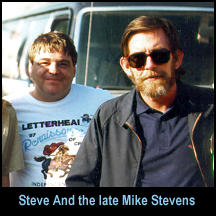 ike would have on our trade.
ike would have on our trade.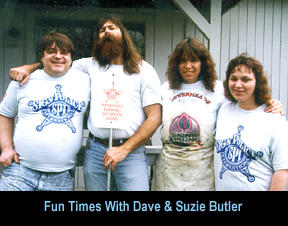 The rest is history. A large
meet was held in Memphis the next year and the movement just kept growing. There are
usually one or two large national meets each year and dozens of smaller regional meets
held all over the world. It's amazing when you think of it, really. The Letterheads
thrive, grow, and evolve without a true governing body. That's right: no president,
treasurer, or even a board of directors.
The rest is history. A large
meet was held in Memphis the next year and the movement just kept growing. There are
usually one or two large national meets each year and dozens of smaller regional meets
held all over the world. It's amazing when you think of it, really. The Letterheads
thrive, grow, and evolve without a true governing body. That's right: no president,
treasurer, or even a board of directors. 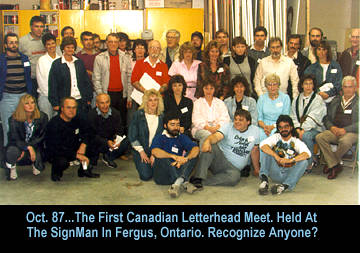 Our turn came in 1987. Ken
Millar and Harry Talon conducted a two-day layout and design course at our new shop in
Fergus, Ontario. Our 1,800-square-foot shop was perfect for this kind of activity, and we
were anxious to show it off. I sat down and called every sign shop I could find in a
75-mile radius and invited them to the First Canadian Letterhead Meet.
Our turn came in 1987. Ken
Millar and Harry Talon conducted a two-day layout and design course at our new shop in
Fergus, Ontario. Our 1,800-square-foot shop was perfect for this kind of activity, and we
were anxious to show it off. I sat down and called every sign shop I could find in a
75-mile radius and invited them to the First Canadian Letterhead Meet. 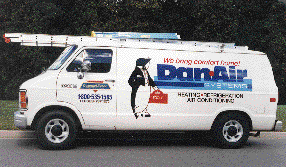
 compressor, spray booth, panel saw and
other toys. Life was looking good.
compressor, spray booth, panel saw and
other toys. Life was looking good.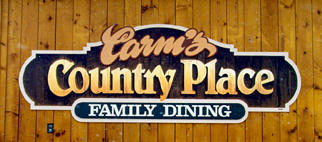 fall back on.
fall back on.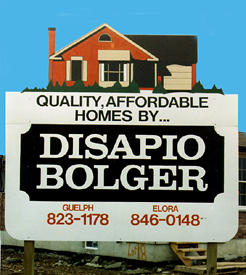 Christmas had become the
most depressing time of the year for me. For some reason, I measured my success as a man
by the size of the present pile under the Christmas tree. A few years earlier, another
small package named John had arrived, and I was now the father of four children!
Christmas had become the
most depressing time of the year for me. For some reason, I measured my success as a man
by the size of the present pile under the Christmas tree. A few years earlier, another
small package named John had arrived, and I was now the father of four children! 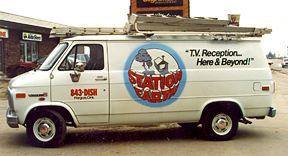 Fergus is just a small town, and
Christmas is the worst possible time to get sick. The usual emergency room staff was off
for Christmas, and the regular doctors had hired a rent-a-doc service to replace them over
the holiday. The staff took blood tests, EKGs and finally shipped me up to Intensive Care.
Fergus is just a small town, and
Christmas is the worst possible time to get sick. The usual emergency room staff was off
for Christmas, and the regular doctors had hired a rent-a-doc service to replace them over
the holiday. The staff took blood tests, EKGs and finally shipped me up to Intensive Care.
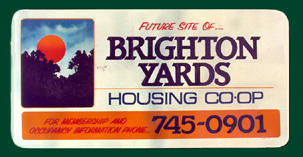 The second heart
attack really weakened me. A trip up the stairs to bed was like climbing Mt. Everest. The
doctors sat me down and in very graphic terms advised me that to go back to the shop was
suicide. The though of not seeing my kids get married and have grandchildren was
depressing.
The second heart
attack really weakened me. A trip up the stairs to bed was like climbing Mt. Everest. The
doctors sat me down and in very graphic terms advised me that to go back to the shop was
suicide. The though of not seeing my kids get married and have grandchildren was
depressing.
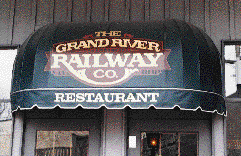 To save money, I convinced Barb I needed Internet service. At that
point she was so frustrated with me she said to do whatever I wanted. At least it would
eliminate the long-distance charges. In early March of 1995, I logged on to the Internet
for the first time.
To save money, I convinced Barb I needed Internet service. At that
point she was so frustrated with me she said to do whatever I wanted. At least it would
eliminate the long-distance charges. In early March of 1995, I logged on to the Internet
for the first time.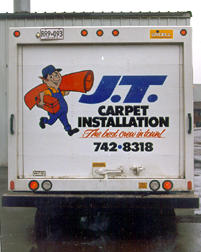 The language used to create
home pages is called HTML (HyperText Markup Language). We made a trip to a book store and
blew what little was left of our savings on books on the Internet and HTML. My first
project was to get The SignMan online. After many days of reading and experimenting, I was
finally able to accomplish this and my first home page on the web was complete.
The language used to create
home pages is called HTML (HyperText Markup Language). We made a trip to a book store and
blew what little was left of our savings on books on the Internet and HTML. My first
project was to get The SignMan online. After many days of reading and experimenting, I was
finally able to accomplish this and my first home page on the web was complete.